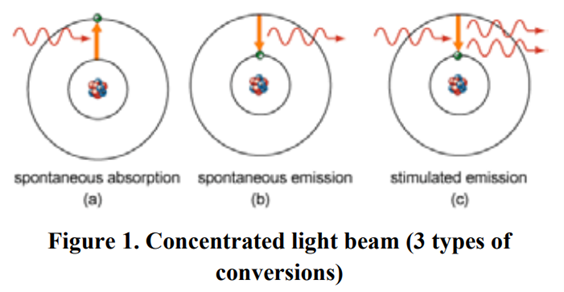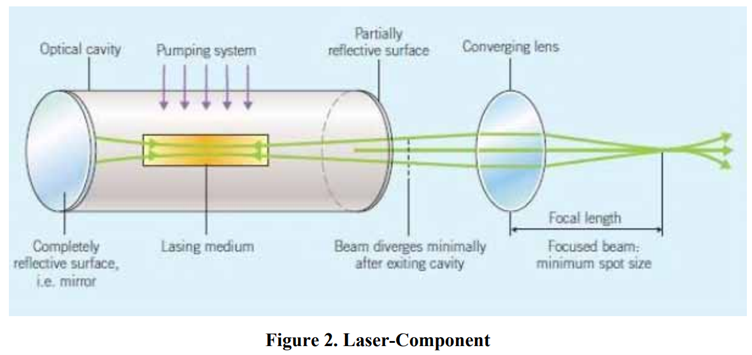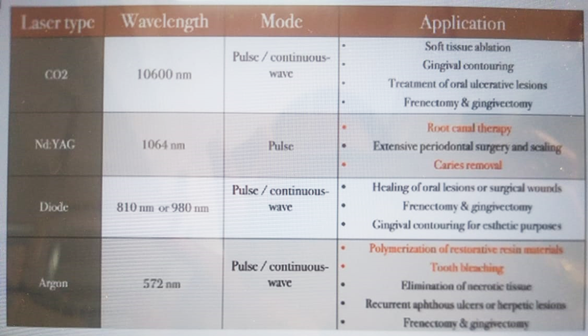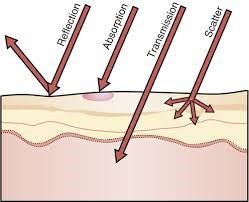Lasers: A Boon in Paediatric Dentistry
M3 India Newsdesk Nov 13, 2024
Laser is a promising arena towards the “minimally invasive”, modern pediatric dental treatments.The fundamentals, classification, and use of lasers in paediatric dentistry are covered in this article, along with some of their benefits and drawbacks.
LASER is “Light Amplification by Stimulated Emission of Radiation”. In 1916 when physicist Albert Einstein explained the stimulated emission theory, the principle of laser came into light. It is an electromagnetic energy with unidirectional and monochromatic unique properties.
Laser physics
- A laser machine forms multiple atoms that pump out multiple photons (known as light particles) all of which line up to form a concentrated light beam.
- Matter consists of atoms. The nucleus lies at the centre of the atom; which contains protons & neutrons. A (+ve) charged is a proton & neutron is neutral. Outside the atom are electrons which are (ve) charged and they are in motion surrounding the nucleus.
- The conversions are of 3 types which are as follows:
- Spontaneous Absorption: An electron alters state to a higher state from a lower state by absorbing a photon (Figure. 1a)
- Spontaneous Emission: An electron spontaneously releases a photon to shift it to a lower state from a higher state (Figure. 1b)
- Stimulated Emission: The electrons transit to a lower state from a higher state & release a photon. The incident photon & their released counterparts possess a similar wavelength. This particular wavelength correlates with the energy difference between two orbits.(1c)

The characteristics of laser-produced from stimulated emission are as follows:
- Monochromatic: Single wavelength light is produced.
- Coherent: All photons show similar polarization & produce a very high intensity when they superpose.
- Collimation: It depicts a narrow & powerful emitted laser beam which consists of constant shape & size.
- Efficiency: At a low energy state lasers produce the required energy to carry out their specified function.
Fundamentals of laser
- Oral tissues have a distinguishing affinity for absorbing laser energy of specific wavelengths.
- Hence, selection of laser depends on target that is to be treated. The optical aspect of target tissue forms basis of laser light interaction in different ways with the intended tissue.
- These interactions are as follows:
- Transmission: Laser energy is transmitted directly through the target tissue without affecting the target tissue.
- Reflection: This property of laser is used for diagnostic purposes. It redirects itself off the surface. It is useful for measuring the ‘sound tooth structure’ in dental caries.
- Absorption: There is the absorption of laser energy in the target tissue on the application of laser on tissue. Different laser wavelengths have a “different absorption coefficient” with the dental tissue components.
“Lasers primarily interact with dental structures photothermally. The temperature of the target tissue increases as laser light is absorbed & when the tissue reaches 100°C temperature, the intercellular & intracellular H2O (water) boils, which induces both soft tissue vaporization or likely to explode & disarrange ‘hard tissue’ (ablation).
With the continued increase in temperature of 200°C, the tissue gets dehydrated & later burned in the presence of the air (carbonisation). Carbon is the end product & it absorbs all wavelengths”.
Laser-component
All lasers have six components which are listed below: [Figure 2]
- Active medium: Materials in the core of the laser, can be gas, solid, liquid, or crystals.
- Pumping mechanism: It is a primary source of energythatis absorbed by the active medium, that results in the “production of laser”.
- Optical resonator: It has a two-mirror system (one is completely reflective & the other one is selectively transmissive) which amplifies and collimates the developing laser beam.
- Cooling subsystem: It cools down the heat produced by a laser.
- Controller subsystem (microprocessor): It is responsible for controlling power output variation to time.
- Delivery system: It is dependent on the wavelength emitted.”

Laser tissue interaction
Classification of Lasers
Lasers have been classified in many ways such as:
I. According to the wavelength (nanometers)
- UV (ultraviolet) range – 140 to 400 nm
- VS (visible spectrum) – 400 to 700 nm
- IR (infrared) range – more than 700 nm
II. Broad classification
1. Hard laser (for surgical work)
- CO2 lasers (CO2 gas)
- Nd: YAG lasers (Yttrium-aluminiumgarnet crystals dotted with neodymium)
- Argon laser (Argon ions)
2. Soft laser (for biostimulation and analgesia)
- He-Ne laser
- Diode lasers
III. Depending on the active medium type:
- Gas lasers
- Argon
- Carbon-dioxide
- Liquid
- Dyes
- Solid
- Nd: YAG
- Erbium: yttrium aluminium garnet (Er: YAG)
- Diode
- Semiconductor
- Hybrid silicon laser
- Excimers
- Argon-fluoride
- Krypton-fluoride
- Xenon-fluoride
IV. According to the pumping scheme
- Optically pumped laser
- Electrically pumped laser
V. According to the operation mode
- Continuous-wave lasers
- Pulsed lasers
VI. The laser classification system is based on the possibility of damage occurring-
- Class I (< 39mw): No threat
- Class II (< 100 MW): It could harm a person if he stares into the beam for a long period. The normal aversion response or blinking should prevent from staring into the beam.
- Class III (500mw): It causes permanent damage including blindness.
VII. Based on clinical use
1. Surgical:
- Hard tissue
- Soft tissue
2. Non-surgical:
- Diagnostic
- Low-level therapy
- Miscellaneous photo-activated disinfection laser-based curing light

Application of lasers in paediatric dentistry
These can be divided into soft tissue and hard tissue procedures.
Soft tissue applications
- Paediatric endodontics
- Treatment of mucocele
- Dentigerous cyst
- Frenectomy
- Ankyloglossia
- Herpes labialis lesions
- Aphthous ulcers
- Exposure of teeth to help in the eruption of teeth
- Gingival remodelling and gingivectomy
- Leukoplakia
Hard tissue applications
- Caries detection by lasers
- Caries removal
- Prevention of enamel and dental caries
- Cavity preparation
- Pit and fissure sealants
- Curing of light-activated composites
- Laser paediatric crowns
- Laser fusion of vertical root fracture
- Removal of old restorative materials
- Orthodontic tooth movement
- Dental traumatology
- Laser analgesia
- Bleaching of vital and non-vital teeth
Role of laser in paediatric dentistry
It provides a positive dental experience with reduced fear and anxiety for paediatric patients. Due to its less invasive nature, children are more cooperative during treatment.
Advantages in Paediatric Dentistry
- No anaesthesia, no drill.
- Less blood loss.
- Reduce post-operative oedema.
- Initial healing, rapid regeneration, reduced post sensitivity in restorations
- Suture and dressing are not required.
- Less chances of metastasis
- Sterilisation of treatment site.
- Tooth enamel is less exposed, resulting in a decrease in caries progression.
- The patient becomes free of fear & anxiety.
- Beneficial for medically compromised patients.
Disadvantages
- Direct light or reflected light can harm the eyes of the practitioner as well as the patient.
- The laser is quite expensive.
- Need qualified personnel.
- Dental hand-pieces are required for finishing, after cavity preparation by laser. Also, it should not be used to fill cavities present between teeth.
- It should not be used for the removal of silver restoration or damaged crowns.
- Possible risk of viral disease transmission from “aerosol” in immune-compromised patients.
Hazards of lasers
Even though the use of lasers in dentistry has increased globally, there are still a lot of risks connected to them. They are as follows:
- Ocular hazard
- Tissue damage
- Respiratory hazard
- Fire and explosion
- Electrical shock
- Combustion hazard
- Equipment hazard
Conclusion
Lasers have been used in dental operatories since 1987 and since then laser technology has advanced significantly. In paediatric dentistry, lasers are a blessing because they reduce discomfort, have analgesic effects on hard tissue, and vibrate, which helps children feel less anxious and more at ease.
Disclaimer- The views and opinions expressed in this article are those of the author and do not necessarily reflect the official policy or position of M3 India.
About the author of this article: Dr Neha Kalantri is a practising dentist from Nashik.
-
Exclusive Write-ups & Webinars by KOLs
-
Daily Quiz by specialty
-
Paid Market Research Surveys
-
Case discussions, News & Journals' summaries
